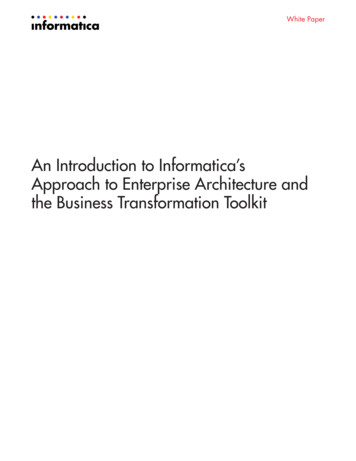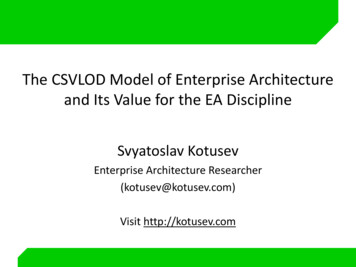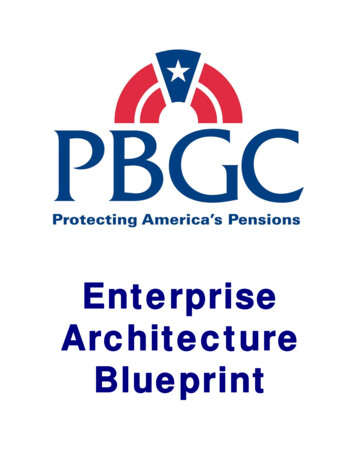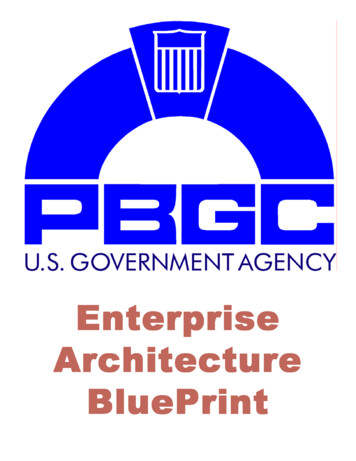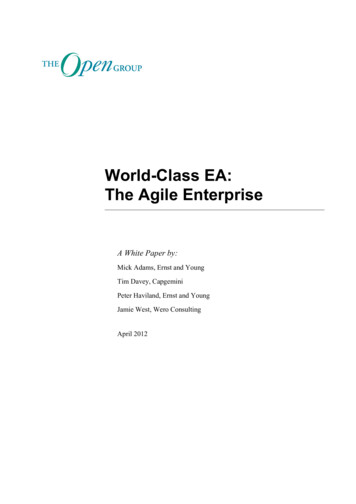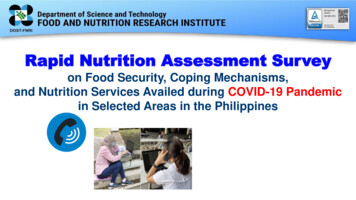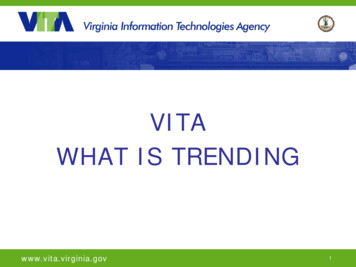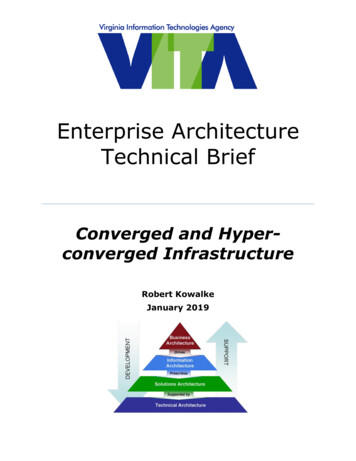
Transcription
Enterprise ArchitectureTechnical BriefConverged and Hyperconverged InfrastructureRobert KowalkeJanuary 2019
Enterprise ArchitectureConverged and Hyper-converged InfrastructureSummaryThis technical brief defines the meaning of converged and hyper-convergedinfrastructure technologies while identifying the pro’s and con’s of each.Guidance from this technical brief is intended to help commonwealth agenciesdetermine which, or both technologies will be useful for them.For any comments, questions, and/or concerns with this technical brief, please contact VITA EA:ea@vita.virginia.govPage 2 of 71January 2019robert.kowalke@vita.virginia.gov
Enterprise ArchitectureConverged and Hyper-converged InfrastructureContentsSummary . 2Converged and Hyper-converged Infrastructure Recommendations . 5Supporting Converged and Hyper-converged Infrastructure Research . 7Converged Infrastructure . 8VITA Server, Storage, and Data Center Services RFP. . 8VITA Critical IT Infrastructure Changes. . 8Building an IT infrastructure [Converged, Hyper-converged and Public Cloud]. . 10Measuring the Business Value of Converged Systems. . 10Converged Infrastructure Benefits and Selection Criteria. . 13Worldwide Quarterly Converged Systems Tracker. . 14Hyper-converged Infrastructure . 15VITA Server, Storage, and Data Center Services RFP. . 15VITA Server & Storage Summary and Recommendations. . 16VITA Critical IT Infrastructure Changes. . 18Hyper-converged Infrastructure Magic Quadrant. . 21Hyperconvergence 101. . 24Hyper Converged Infrastructure vs Converged Infrastructure. . 25The Business Value of Modernizing Infrastructure with Hyper-Converged Systems. . 26Dell State of IT Trends 2016 Survey Results. . 28Tech Trends 2018: The Symphonic Enterprise. . 30Hyperconvergence Today: A Technical Market Guide. . 31Building an IT infrastructure [Converged, Hyper-converged and Public Cloud]. . 35Choosing the Right Container Infrastructure for your Organization. . 35Moving Beyond Disaster Recovery to Achieve IT Resilience. . 38Overcoming Inertia - Mitigating Hyper-convergence's Perceived Challenges. . 38The Data Center is dead – Long live the Data Center. . 40Make it Real - Dell Technologies World Conference. . 41Hyper-Convergence: Infrastructure in a Box. . 42Three (3) Reasons to Beware the Hype around Hyperconverged. . 45Exploring the True Cost of Converged vs. Hyperconverged Infrastructure (HCI). . 47Page 3 of 71January 2019robert.kowalke@vita.virginia.gov
Enterprise ArchitectureConverged and Hyper-converged InfrastructureConsiderations for the Next Phase of Hyperconverged Infrastructure. . 49Next Generation Data Centers: Hyperconverged Architectures Impact on Storage. . 50Pictorial Insight of Converged and Hyper-converged Infrastructure Technologies . 51Converged Infrastructure . 52Hyper-converged. 59Page 4 of 71January 2019robert.kowalke@vita.virginia.gov
Enterprise ArchitectureConverged and Hyper-converged InfrastructureConverged and Hyper-converged InfrastructureRecommendations1. The Commonwealth is interested in newer technical solutions includingconverged infrastructure (CI) and hyper-converged infrastructure (HCI). CI andHCI represent various methods that positively increase infrastructureefficiencies, and should be considered by agencies as suitable solutions.a. For CI and HCI offerings, VITA recommends:i. CI and HCI that is:1. hardware and hypervisor-agnostic.2. support DRAM and flash devices from any vendor.3. have a disk infrastructure that is direct, and legacy SANattached, to fully realize expected ROI from one’s SAN.4. can virtualize all storage capacity allowing management ofcapacity allocations and special storage services at multiplesites, and on heterogeneous storage gear from a singlesoftware interface.ii. Use of CI where it supports relevant business requirements and usecases, because it provides the most flexibility to respond to theunpredictable challenges in the future while still providingconvergence advantages.iii. Use of CI/HCI for larger applications such as Oracle, MicrosoftExchange, SAP, etc.1. When choosing to implement a converged storage solution(CI/HCI), be sure to review any new DAS utilization.iv. Use of HCI hyper-converged architectures in agencies where:1. there is no dedicated IT staff.2. technical expertise does not support traditional ITinfrastructure support.3. virtual desktop infrastructure (VDI) deployments are beingconsideredPage 5 of 71January 2019robert.kowalke@vita.virginia.gov
Enterprise ArchitectureConverged and Hyper-converged Infrastructurev. Using HCI where it supports relevant business requirements anduse cases, because it simplifies the procurement process byproviding a single SKU product.Page 6 of 71January 2019robert.kowalke@vita.virginia.gov
Enterprise ArchitectureConverged and Hyper-converged InfrastructureConverged InfrastructureandHyper-converged InfrastructureResearchPage 7 of 71January 2019robert.kowalke@vita.virginia.gov
Enterprise ArchitectureConverged and Hyper-converged InfrastructureConverged InfrastructureVITA Server, Storage, and Data Center Services RFP. 5.2: Server, Storage, Network, and Data Center Services Evolutiono R490: The Commonwealth is interested in newer technicalServices solutions which may include technical and/or physicalchanges (e.g. hyper-converged, converged, Software DefinedNetwork (SDN), solid-state storage, data center services).VITA Critical IT Infrastructure Changes. 12Converged infrastructure (CI).o Brings the four core aspects of a data center into building blockapproach of a single chassis tied together in a centralizedmanagement platform. Compute, Storage, Networking, and Server.1VITA Exhibit 2.1, Description of Services, Server, Storage and Data Center Services, RFP 2017-04: Server,Storage and Data Center by Supply Chain Management Division in 2017.2VITA - Critical IT Infrastructure Changes by Todd D. Kissam (VITA Chief Enterprise Architect) on August 10, 2017.Page 8 of 71January 2019robert.kowalke@vita.virginia.gov
Enterprise ArchitectureConverged and Hyper-converged Infrastructure Eliminates former technology silos.o Can, but not always, comprise systems from different vendors.o Tend to be designed to scale to a specific size. Expansion is no small task.Benefits of CI.o CI ready-made.o Integrate, pre-test, and pre-configure systems prior to shippingto customers.o Customers unpack box, plug it into network and power, andsystem is ready to use.o CI chosen for deployment and management ease instead of thebenefits of an open, interoperable system with choice ofcomponents.o Simplicity overcomes choice.Page 9 of 71January 2019robert.kowalke@vita.virginia.gov
Enterprise ArchitectureConverged and Hyper-converged InfrastructureBuilding an IT infrastructure [Converged, Hyper-convergedand Public Cloud]. 3 The major components of an ITinfrastructure include:o Computer hardware.o Operating systems.o Enterprise and other applications.o Data management and storage.o Networking platforms.o Internet platforms.What is Converged Infrastructureo Converged infrastructure helps combine all the differentdisparate elements that power IT including managementsoftware, servers, applications, and virtualization.o Overall, CI helps lower compatibility issues by reducing costs forpower, floor space, cooling, and cabling.While converged infrastructures may be installed on bare metalservers, in most cases all components are virtualized.o Creates a cost effective and highly automated infrastructure,which responds quickly to changing requirements without havingto reorganize physical components or get new ones.There are disadvantages to converged infrastructure, such as: 1) Theratio of resources, including CPU, network, and storage are predefinedand not as flexible as some users may want; 2) Products cannotalways be used for existing legacy systems or prevailing infrastructure.o Hyper-convergence infrastructure takes convergenceinfrastructure to a completely new level by adding the benefits ofconvergence together and going beyond storage and servers.Measuring the Business Value of Converged Systems. 4Three key strategies for getting the most from converged systems:o Datacenter transformation.o Application-specific acceleration.o New service creation.Building an IT infrastructure [Converged, Hyper-converged, and Public Cloud] by Simform in August 22, 2017.Downloaded from the internet in December 2018.4Measuring the Business Value of Converged Systems by IDC and sponsored by HPE in December 2014.Downloaded from the internet in December 2018.3Page 10 of 71January 2019robert.kowalke@vita.virginia.gov
Enterprise ArchitectureConverged and Hyper-converged Infrastructure Of organizations in the survey that had been transitioning toconverged infrastructures, improvements in each of the followingmetrics were realized:o Mean time to deploy new services such as a new application.Page 11 of 71January 2019robert.kowalke@vita.virginia.gov
Enterprise ArchitectureConverged and Hyper-converged Infrastructureo Percentage of staff time spent “Keeping the lights on”.o Downtime hours per user per year.o Annual IT costs per year.Page 12 of 71January 2019robert.kowalke@vita.virginia.gov
Enterprise ArchitectureConverged and Hyper-converged InfrastructureConverged Infrastructure Benefits and Selection Criteria. 5The data center has a significant influence on a company’s success.o “Converged infrastructure” is a technology that can be used as abasis for a high-performance, efficient data center.A converged infrastructure combines data center components into acentrally managed system.o Such systems are closely integrated components inpreconfigured appliances or reference architectures (blueprints)for the set-up and centralized management of a (scalable)infrastructure.o Consist of network, storage, and compute resources equippedwith orchestration and life cycle management software.Converged systems feature a lower degree of integration, ensuringmore freedom regarding the structure, and later extension of thesystem, specifically when it comes to individual (storage and compute)components, where granular extension ispossible.o A major advantage for userorganizations that must ensure optionsto respond flexibly to unpredictablechallenges of the future.o Considering the long-term character ofdata center investments, this decisionmaking factor should not beunderestimated.Converged systems can address users’ need for fast and cost-efficientdeployment.o Converged systems, with their tightly integrated andpreconfigured components, and validated architecture blueprints,make it easier to build up a data center.o Converged system providers take over a large part of tasks,reducing users’ workload accordingly.o Secure solutions.o Efficient support.Converged Infrastructure Benefits and Selection Criteria by Information Services Group (ISG) in Frankfurt,Germany in April 2018. Obtained from the internet in December 2018.5Page 13 of 71January 2019robert.kowalke@vita.virginia.gov
Enterprise ArchitectureConverged and Hyper-converged Infrastructure Converged infrastructure solutions provide many benefits, includingfast implementation, easy management, flexibility, high performanceand efficient support.Worldwide Quarterly Converged Systems Tracker. 6Organizations around the world are increasing their investments ondatacenter technologies that eliminate inefficient silos and supportbusiness-centric decisions rather than infrastructure-centric decisions.o This is driving increased spending on converged systems thatcan safely reduce the complexity of datacenter infrastructure andallow IT teams to focus on high-value business projects.IDC defines converged systems as pre-integrated, vendor-certifiedsystems containing server hardware, disk storage systems, networkingequipment, and basic element/systems management software.Worldwide Quarterly Converged Systems Tracker by IDC, a subsidiary of IDG in March-2018. Downloaded fromthe internet in December 2018.6Page 14 of 71January 2019robert.kowalke@vita.virginia.gov
Enterprise ArchitectureConverged and Hyper-converged InfrastructureHyper-converged InfrastructureVITA Server, Storage, and Data Center Services RFP. 75.0: Server/Storage/Network Documentation, Analysis, and Evolution.o R446: VITA and its Customers provide essential services to thecitizens of Virginia. Many of these essential services depend ona stable computing environment providing Server, Storage, andDirectory Services. VITA and its Customer Agencies have takena very conservative approach to technology over the last decadeand are now interested in exploring the performance andefficiency improvements that are available via new and emergingtechnologies such as Software Defined Networks and hyperconverged environments.5.2: Server, Storage, Network, and Data Center Services Evolution.o R490: The Commonwealth is interested in newer technicalServices solutions which may include technical and/or physicalchanges (e.g. hyper-converged, converged, Software DefinedNetwork (SDN), solid-state storage, data center services).VITA Exhibit 2.1, Description of Services, Server, Storage and Data Center Services, RFP 2017-04: Server,Storage and Data Center by Supply Chain Management Division in 2017.7Page 15 of 71January 2019robert.kowalke@vita.virginia.gov
Enterprise ArchitectureConverged and Hyper-converged InfrastructureVITA Server & Storage Summary and Recommendations. 8Servers (General): Recommended Tactical Directiono Converged or hyper-converged technology means serversupplier provides data center networks.Storage: Future Trendso Hyper-converged technology can deliver SAN, NAS, or DAS inany combination. Same hardware (high-performance SSD drives (e.g.NVMe) utilizing peripheral component interconnect express(PCIe) technology.Storage: Recommended Tactical Directiono Prepare for hyper-converged solutions. Initially, new provider may use converged technology tosupport service transition. Dell EMC VCE vBlock still expensive, but moreflexible than current VITA SAN.o If converged technology, review any new DAS utilization.VITA Server & Storage Summary and Recommendations presentation by Todd D. Kissam (VITA Chief EnterpriseArchitect) in July 2017.8Page 16 of 71January 2019robert.kowalke@vita.virginia.gov
Enterprise ArchitectureConverged and Hyper-converged InfrastructurePage 17 of 71January 2019robert.kowalke@vita.virginia.gov
Enterprise ArchitectureConverged and Hyper-converged InfrastructureVITA Critical IT Infrastructure Changes. 99HCI technology is software defined.o Technology is integrated in such a way that it cannot be brokenout into its separate components.VITA - Critical IT Infrastructure Changes by Todd D. Kissam (VITA Chief Enterprise Architect) on August 10, 2017.Page 18 of 71January 2019robert.kowalke@vita.virginia.gov
Enterprise ArchitectureConverged and Hyper-converged InfrastructurePage 19 of 71January 2019robert.kowalke@vita.virginia.gov
Enterprise ArchitectureConverged and Hyper-converged Infrastructure Perhaps the most impactful of both converged and hyper-convergedbenefits are the ability to provision, test, and deploy IT dramaticallyfaster.o Major reduction of time and resources needed to manage andmaintain the infrastructure once operational.o Not merely benefits claimed by vendors; they are increasinglyproven and documented.HCI takes the CI integration process a step further by adding thefeatures of storage and server virtualization together in a singlehardware offering.HCI can be deployed on as little as four servers.HCI is particularly valuable for VDI because it can scale up quicklywithout a ton of added expense.o Often comes with a lot of flash, which is great for virtual desktopperformance.o Reduces complexity and costs.HCI technology is software defined.o It is integrated in such a way that it cannot be broken out intoits separate components.Page 20 of 71January 2019robert.kowalke@vita.virginia.gov
Enterprise ArchitectureConverged and Hyper-converged Infrastructure HCI means:o Server/storage vendor will also supply network within datacenterso Lower cost of infrastructureo Agencies consume platforms as opposed to infrastructure, so nochange in services other than quicker provisioningHyper-converged Infrastructure Magic Quadrant. 1010Hyper-converged infrastructure (HCI) is a category of scale-outsoftware-integrated infrastructure that applies a modular approach tocompute, network, and storage on standard hardware, leveragingdistributed, horizontal building blocks under unified management.o HCI vendors either build their own appliances using common,off-the-shelf infrastructure (hardware, virtualization, operatingHyper-converged Infrastructure Magic Quadrant by Gartner - Nov-27-2018.Page 21 of 71January 2019robert.kowalke@vita.virginia.gov
Enterprise ArchitectureConverged and Hyper-converged Infrastructure system), or they engage with system vendors that package theHCI vendor’s software stack as an appliance.Vendor approaches to HCI include:o A storage virtualization and data management perspective Partnering for all other components of the HCI stack(hypervisor, network virtualization, management).o A server virtualization perspective Add storage virtualization and data management serviceslater.o A hardware appliance perspective as the natural evolution of aserver vendor’s installed base of x86 servers. Either acquired an existing HCI or hyperconvergedintegrated system (HCIS) company, or partnered withmultiple HCI companies to deliver appliances or referencearchitectures.o A full-stack perspective. A startup is willing to compete head-to-head with leadinghypervisor suppliers by initially focusing on a single niche.o A larger software offering with public cloud is an integral part ofthe strategy This applies to Microsoft who is also a public cloud vendor.For Microsoft, the hypervisor, storage, and datamanagement services are a no-additional-charge feature.Whereas, for most HCI vendors, the public cloud is anPage 22 of 71January 2019robert.kowalke@vita.virginia.gov
Enterprise ArchitectureConverged and Hyper-converged Infrastructureextension of the strategy making it potentially a strategicthreat to Microsoft.Page 23 of 71January 2019robert.kowalke@vita.virginia.gov
Enterprise ArchitectureConverged and Hyper-converged InfrastructureHyperconvergence 101.11Hyperconvergence 101: A crash course in redefining your infrastructure by EMC / ePlus in 2016. Downloaded inDecember 2018.11Page 24 of 71January 2019robert.kowalke@vita.virginia.gov
Enterprise ArchitectureConverged and Hyper-converged InfrastructureHyper Converged Infrastructure vs ConvergedInfrastructure. 12 Hyper converged infrastructure is often named HCI.o Introduce in 2012, HCI describes a fully software-defined ITinfrastructure that virtualizes all the elements of conventionalhardware-defined systems.o Generally, hyper converged infrastructure is at least composedof virtualized computing (a Hypervisor), a virtualized SAN(software-defined storage) and virtualized networking (Softwaredefined networking).o It can be utilized as a way to pool together resources tomaximize the interoperability of on-premises infrastructure.Hyper Converged vs Converged Infrastructure ComponentsHyper Converged Infrastructure vs Converged Infrastructure by Network Solutions' Amelia Liu on October 27,2017. Obtained via the internet in December 2018.12Page 25 of 71January 2019robert.kowalke@vita.virginia.gov
Enterprise ArchitectureConverged and Hyper-converged Infrastructureo Converged infrastructure defines compute, storage, networkingand server virtualization—which are the four core components ina data center—as one dense building block.o Hyper-converged infrastructure was born from convergedinfrastructure and the idea of the software-defined data center(SDDC). Besides the data center’s four core components, hyperconverged infrastructure integrates more components suchas backup software, snapshot capabilities, datadeduplication, inline compression, WAN optimization andso on.The Business Value of Modernizing Infrastructure withHyper-Converged Systems. 13 Business value of HCI highlights:o Five (5) year ROI – 619%.o Six (6) months to payback.o Lower cost of operations – 59%.o Faster to deploy – 73%.o Less staff time to deploy storage – 81%.o Less unplanned downtime – 98%.o Improved application performance – 42%.The Business Value of Modernizing Infrastructure with Hyper-Converged Systems by International DataCorporation (IDC) in October 2017. Obtained from the internet in December 2018.13Page 26 of 71January 2019robert.kowalke@vita.virginia.gov
Enterprise ArchitectureConverged and Hyper-converged InfrastructurePage 27 of 71January 2019robert.kowalke@vita.virginia.gov
Enterprise ArchitectureConverged and Hyper-converged InfrastructureDell State of IT Trends 2016 Survey Results. 14More than 8 in 10 of ITDMs and BDMs agree that integrating hyperconverged solutions is the first step in achieving a software-defineddata center (SDDC).o BDM Business Decision Makers.o ITDM IT Decision Makers.o An SDDC is a top enabler to digital transformation.o ITDMs more likely to mention hybrid/multi-cloud as a topenabler.Dell State of IT Trends 2016 Survey Results conducted by PSB in July 2016. Obtained from the internet inDecember 2018.14Page 28 of 71January 2019robert.kowalke@vita.virginia.gov
Enterprise ArchitectureConverged and Hyper-converged InfrastructurePage 29 of 71January 2019robert.kowalke@vita.virginia.gov
Enterprise ArchitectureConverged and Hyper-converged InfrastructureTech Trends 2018: The Symphonic Enterprise. 15Over the next 18 to 24 months, wewill likely see CIOs beginreengineering not only their IT shopsbut, more broadly, their approachesto technology.Expect to seemany CIOs deploy a two-prongedstrategy.o From the bottom up, they canfocus on creating an ITenvironment in whichinfrastructure is scalable anddynamic and architecture isopen and extendable.o From the top down, CIOs andtheir teams have anopportunity to transform howthe shop budgets, organizes,staffs, and delivers services.Companies want to use software-defined everything, to automateplatforms, and to extrapolate infrastructure to code.o It is not atypical these days for a company to have thousands ofdevelopers and thousands of applications, but only a handful ofinfrastructure or operations resources. Of course, they still need physical infrastructure, but theyare automating the management, optimization, andupdating of that infrastructure with software.o Our customers want to put their money into changing thingsrather than simply running them; they want to reengineer theirIT stacks and organizations to be optimized for speed andresults. In doing so, IT is being seen as BT – “businesstechnology,” with priorities directly aligned to customerimpact and go-to-market outcomes.Tech Trends 2018: The Symphonic Enterprise – Deloitte Insights; Deloitte Consulting LLP's TechnologyConsulting Practice. Obtained via the internet in December 2018.15Page 30 of 71January 2019robert.kowalke@vita.virginia.gov
Enterprise ArchitectureConverged and Hyper-converged InfrastructureHyperconvergence Today: A Technical Market Guide. 1616Hyperconverged is increasingly the default option for data centerinfrastructure buyers.It is a great building block for private/hybrid cloud.Makes building and maintaining infrastructure easier.Not suitable for every workload.Hyperconvergence Today: A Technical Market Guide by Gartner - August 2018. Obtained September 2018.Page 31 of 71January 2019robert.kowalke@vita.virginia.gov
Enterprise ArchitectureConverged and Hyper-converged InfrastructurePage 32 of 71January 2019robert.kowalke@vita.virginia.gov
Enterprise ArchitectureConverged and Hyper-converged InfrastructurePage 33 of 71January 2019robert.kowalke@vita.virginia.gov
Enterprise ArchitectureConverged and Hyper-converged Infrastructure For most major vendors, public cloud IaaS is included in the box.Know the product’s roadmap that you’re thinking of purchasingbecause today’s hyper-converged products will change substantiallyPage 34 of 71January 2019robert.kowalke@vita.virginia.gov
Enterprise ArchitectureConverged and Hyper-converged Infrastructureover a three (3) to five (5) year duty cycle, including many vendorsthat will not be in the business in five years.Building an IT infrastructure [Converged, Hyper-convergedand Public Cloud]. 17 Enterprises have embraced the cloud (pay as you go model) in the lastdecade, but the move data from legacy systems was a struggle andthat is how hyper-converged and converged architecture appeared.The biggest difference betweenconverged and hyper-convergedinfrastructure is that while CI is hardware-based, HCI is softwarebased.o HCI is designed to cut 4 to 60 percent of costs from legacyinfrastructure by removing separate storage networking andproprietary storage hardware.Enterprises are using HCI for to: 1) Deploy new tier-1 applications; 2)Provide better backup and disaster recovery; 3) Enable smoothertransitions; 4) Manage resources remotelyThe Benefits of Hyper-Converged Infrastructure include:o Scalability.o Better Mobility and Data Availability.o Automation and Agility.Choosing the Right Container Infrastructure for yourOrganization. 18Container adoption is accelerating rapidly with Gartner predicting morethan 50% of new workloads will be deployed into containers in 2018.Docker expects 30x growth of containerized apps in two years.Bare metal is the gold standard for production containers.o Why?Building an IT infrastructure [Converged, Hyper-converged, and Public Cloud] by Simform in August 22, 2017.Downloaded from the internet in December 2018.18Choosing the Right Container Infrastructure for your Organization by Diamanti on April 12, 2018. Obtained fromthe internet in December 2018.17Page 35 of 71January 2019robert.kowalke@vita.virginia.gov
Enterprise ArchitectureConverged and Hyper-converged Infrastructure Bare-metal containers provide optimal performance,allowing applications to access hardware without the needfor pass-through, or hardware emulation.Bare-metal delivers many of the perceived advantages ofvirtualization including application portability and isolation. Running containers inside virtual machines is likedoing virtualization on top of virtualization – totallyunnecessary.Interestingly, existing IT infrastructure optimized over a period ofmany years for virtualized business applications may not efficientlysupport containers.o As you navigate the transition from virtualization, you’ll needinfrastructure that addresses the unique needs of a containerenvironment.Page 36 of 71January 2019robert.kowalke@vita.virginia.gov
Enterprise ArchitectureConverged and Hyper-converged Infrastructureo A variety of vendors have created converged andhyperconverged infrastructure solutions to reduce thecomplexity of IT infrastructure deployment: Converged infrastructure (CI) pre-packages severalservers with a separate storage array. Hyperconverged infrastructure (HCI) combinesservers with internal storage, software to virtualize thatstorage, and virtualization software such as VMwarevSphere.o These solutions can be deployed for use in containerenvironments, however, as a class, they are designed forvirtualization rather than containers, making bare-metalcontainer deployment impossible in almost all cases.Page 37 of 71January 2019robert.kowalke@vita.virginia.gov
Enterprise ArchitectureConverged and Hyper-converged Infrastructure The vendors themselves remain largely focused onvirtualization.The level of support you will get from a vendor foreverything in the infrastructure stack above virtualizationcould be minimal.You may have to rely on the open-source community forcontainer and orchestration support.Moving Beyond Disaster Recovery toAchieve IT Resilience. 19 The most exciting benefits for adopters ofhyperconverged infrastructure include:o Focus on the workload.o D
Converged and Hyper-converged Infrastructure Building an IT infrastructure [Converged, Hyper-converged and Public Cloud]. 3 The major components of an IT infrastructure include: o Computer hardware. o Operating systems. o Enterprise and other applications. o Data management and storage. o Networking platforms. o Internet platforms.

